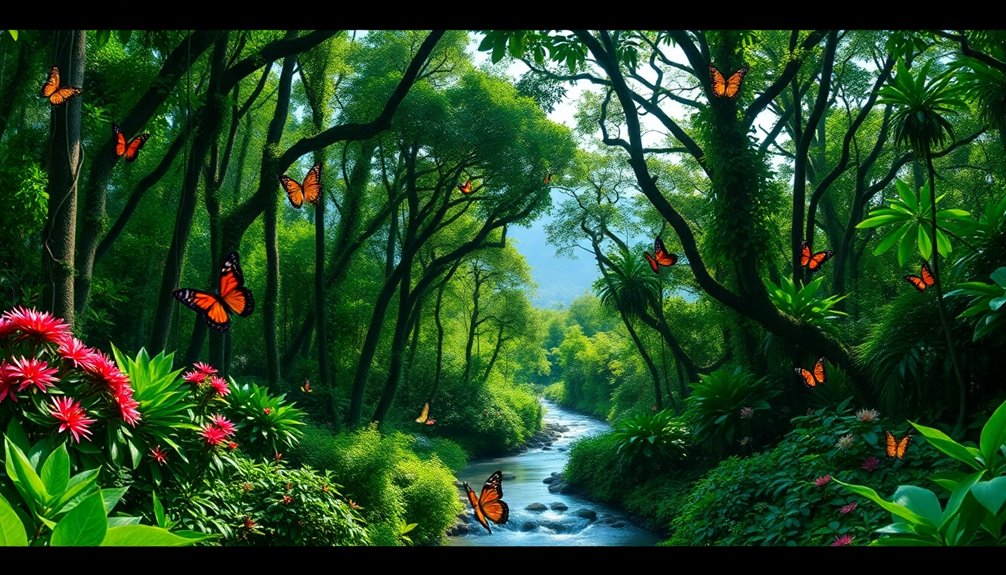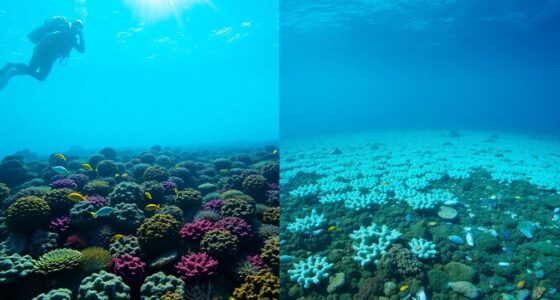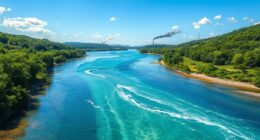Biodiversity hotspots are regions with rich unique species, fundamental for global ecosystems. They must have at least 1,500 endemic plant species and have lost 70% of their original natural vegetation. These areas provide essential ecological services, support local communities, and face threats like habitat destruction and climate change. Protecting these hotspots is critical for maintaining ecological balance. Discover the challenges they face and the strategies for their conservation to understand their significance even further.
Key Takeaways
- Biodiversity hotspots are regions with at least 1,500 endemic plant species and significant habitat loss of over 70% of original vegetation.
- These areas cover only 2.5% of Earth's land but host over half of the world's endemic plant species and a large number of vertebrates.
- They provide crucial ecosystem services, supporting food security, carbon storage, and water purification for billions of people globally.
- Biodiversity hotspots face threats from habitat destruction, climate change, pollution, and invasive species, risking over 40% of animal species.
- Effective conservation strategies involve establishing protected areas, community involvement, funding initiatives, and promoting eco-tourism to ensure sustainability.
Definition of Biodiversity Hotspots

Biodiversity hotspots are crucial regions that showcase an impressive array of unique plant and animal species. To qualify as a biodiversity hotspot, an area must contain at least 1,500 species of vascular plants as endemics and have lost at least 70% of its original natural vegetation. This loss highlights significant threats to these ecosystems.
Currently, there are 36 recognized biodiversity hotspots worldwide, representing just 2.5% of Earth's land surface but hosting over half of the world's endemic plant species. These hotspots are biologically rich, supporting nearly 43% of endemic vertebrate species, and play a critical role in maintaining global biodiversity.
Sadly, they're also at high risk of extinction, making their protection essential for future generations.
Importance of Biodiversity Hotspots
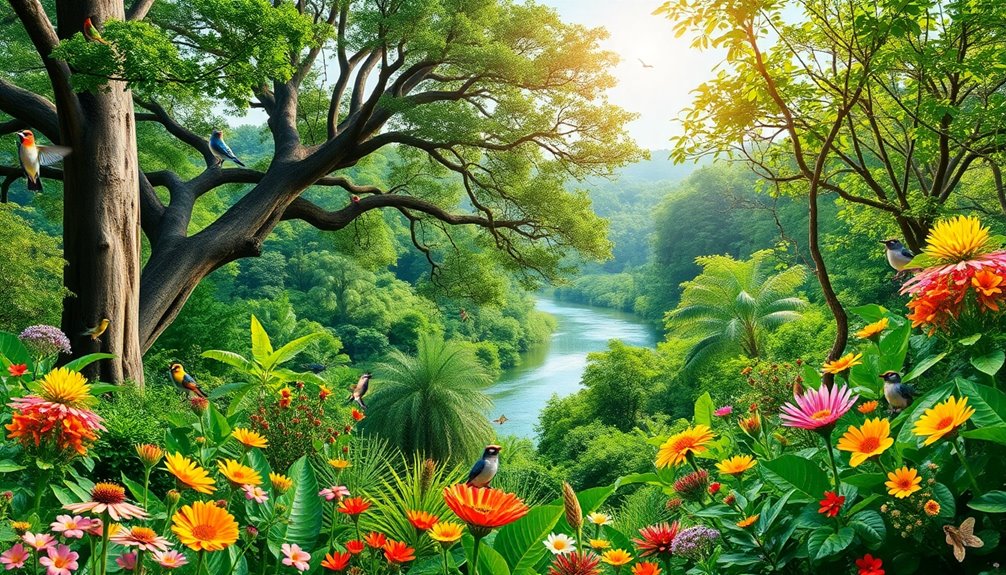
Biodiversity hotspots are essential for your survival, as they provide indispensable ecosystem services like pollination and water purification.
Covering just a small fraction of the Earth's surface, these regions support a significant portion of the world's unique plant and animal species.
Ecosystem Services Provided
While you mightn't realize it, biodiversity hotspots play an important role in providing essential ecosystem services that underpin human survival.
These areas contribute about 35% of the ecosystem services we rely on, including clean water, food production, and climate regulation. They support over half of the world's endemic plant species and nearly 43% of endemic vertebrate species, emphasizing their significance in maintaining biological diversity.
Ecosystem services like pollination and soil fertility are essential for agricultural productivity, ensuring food security for billions. Additionally, these unique ecosystems aid in carbon storage, helping to mitigate climate change impacts.
Conservation organizations focus on protecting biodiversity hotspots to combat habitat loss and enhance ecosystem resilience, which is imperative for adapting to environmental changes.
Human Survival Dependency
Without a doubt, the survival of billions hinges on the health of biodiversity hotspots. These essential areas provide important ecosystem services that support about 2 billion people, especially those relying on natural resources for clean water, food security, and medicine.
Biodiversity hotspots are home to over 50% of the world's endemic species, making them critical for maintaining global biodiversity. They contribute considerably to climate regulation and pollination, supporting human survival.
However, with more than 40% of animal species in these regions facing high extinction risk, protecting biodiversity hotspots becomes imperative. By safeguarding these areas, we not only preserve unique species but also guarantee the continued availability of ecosystem services that sustain our lives and mitigate climate change impacts.
Global Distribution of Biodiversity Hotspots

Across the globe, 36 recognized biodiversity hotspots showcase a stunning array of ecosystems that thrive in unique environments.
These hotspots, like the Amazon rainforest, Madagascar, and the Himalayas, cover just 2.5% of Earth's land but host over half of the world's endemic plant species and nearly 43% of endemic vertebrate species.
You'll find these irreplaceable species in tropical forests, wetlands, and coastal areas, all essential for conservation efforts.
Unfortunately, many biodiversity hotspots overlap with densely populated regions, intensifying their vulnerability to habitat loss due to human activity.
Protected areas within these hotspots are fundamental for maintaining biodiversity, ensuring that these ecosystems continue to flourish while safeguarding the unique life forms that depend on them.
Threats to Biodiversity Hotspots

The rich ecosystems found in biodiversity hotspots are increasingly under threat, primarily due to habitat destruction. Urbanization and agriculture lead to significant land conversion, while overexploitation of natural resources further exacerbates the loss of biodiversity. Climate change poses a major risk, potentially affecting the survival of nearly 25% of species within these areas. Invasive species disrupt local ecosystems, threatening native flora and fauna. Pollution, particularly from water and soil contamination, jeopardizes ecosystem health.
| Threat Type | Impact on Biodiversity |
|---|---|
| Habitat Destruction | Land conversion and fragmentation |
| Climate Change | Species survival risk |
| Invasive Species | Decline of native species |
| Pollution | Ecosystem health degradation |
| Overexploitation | Resource depletion |
Supporting efforts by organizations like Conservation International is essential for protecting these critical areas.
Criteria for Identifying Biodiversity Hotspots

To identify biodiversity hotspots, regions must meet specific criteria that highlight their ecological uniqueness and the urgent need for conservation.
First, a hotspot must contain at least 1,500 species of vascular plants that are endemic, showcasing its ecological significance. Additionally, the area must have lost at least 70% of its original natural vegetation, emphasizing the vital conservation need.
Currently, there are 36 recognized biodiversity hotspots, covering only 2.5% of Earth's land but supporting over half of the world's endemic plant species.
Alarmingly, more than 40% of the animal species in these hotspots face high extinction risks, underscoring their essential role in global biodiversity conservation efforts.
Recognizing these criteria helps prioritize areas in dire need of protection.
Strategies for Conservation and Protection
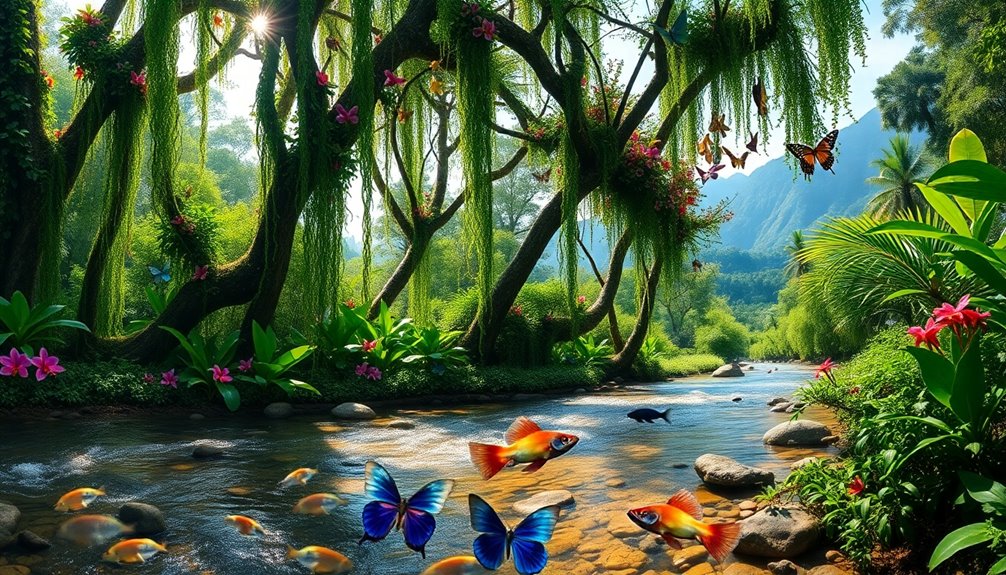
While protecting biodiversity hotspots is essential, effective strategies must focus on collaboration and community engagement.
Establishing protected areas is fundamental for conserving essential ecosystems and mitigating human impact. By involving local communities in conservation efforts, you can guarantee they benefit from sustainable resource management and recognize the value of preserving their environment.
Funding initiatives, like the Critical Ecosystem Partnership Fund (CEPF), can provide necessary financial support for strategic investments that lead to ecological restoration.
Promoting eco-tourism creates economic opportunities while fostering environmental awareness.
Collaboration among governments, businesses, and civil society enhances the effectiveness of these strategies, securing the long-term sustainability and resilience of biodiversity hotspots.
Engaging everyone is key to making a real difference in conservation efforts.
Human Population in Biodiversity Hotspots

In biodiversity hotspots, high population density poses significant challenges for conservation efforts.
You'll find that many impoverished communities depend on these ecosystems for survival, which often leads to conflicts between human needs and ecological preservation.
Understanding the socioeconomic impacts of human activities is essential for finding effective solutions to protect both biodiversity and these vulnerable populations.
Population Density Challenges
As human populations swell in biodiversity hotspots, the delicate balance between ecological preservation and community needs becomes increasingly strained.
With around 2 billion people relying on these ecosystems, high human population densities create significant challenges:
- Increased pressure on natural resources leads to habitat degradation.
- Urbanization and agriculture intensify deforestation, threatening biodiversity.
- Pollution directly impacts endemic species, raising extinction risks.
- Effective conservation strategies must address socio-economic needs to guarantee local livelihoods.
Navigating these complexities is imperative.
Without a thoughtful approach that harmonizes human well-being and the protection of biodiversity hotspots, we risk losing both critical ecosystems and the communities that depend on them.
It's important to find solutions that benefit nature and people alike.
Socioeconomic Impacts on Conservation
The interplay between human populations and biodiversity hotspots greatly influences conservation efforts. With around 2 billion people living in these areas, many rely on ecosystems for survival, needing clean water and other essential ecosystem services.
However, high population densities can lead to habitat degradation and biodiversity loss, threatening both plant species and human livelihoods. Socioeconomic challenges like poverty and limited education further complicate conservation initiatives.
Urbanization and agricultural practices intensify these pressures, making it difficult to balance human needs with the health of these essential ecosystems. To foster effective conservation, it's important to address these socioeconomic factors, ensuring that communities can sustainably benefit from biodiversity hotspots while protecting their rich natural resources.
The Current State of Biodiversity Hotspots

Biodiversity hotspots represent some of the planet's most essential ecosystems, yet they face unprecedented challenges. You need to be aware of the following critical issues:
- Extinction Rates: Over 40% of animal species in these hotspots are at high risk of extinction.
- Habitat Loss: Some regions have lost up to 95% of their original vegetation due to urbanization and agriculture.
- Endemic Species: These hotspots are home to over 50% of the world's endemic plant species and nearly 43% of endemic vertebrate species.
- Climate Change: This poses significant threats, impacting the survival of nearly 25% of species and worsening habitat loss.
Urgent conservation efforts are essential, as biodiversity hotspots provide 35% of essential ecosystem services for about 2 billion people.
Our Work in Biodiversity Hotspots
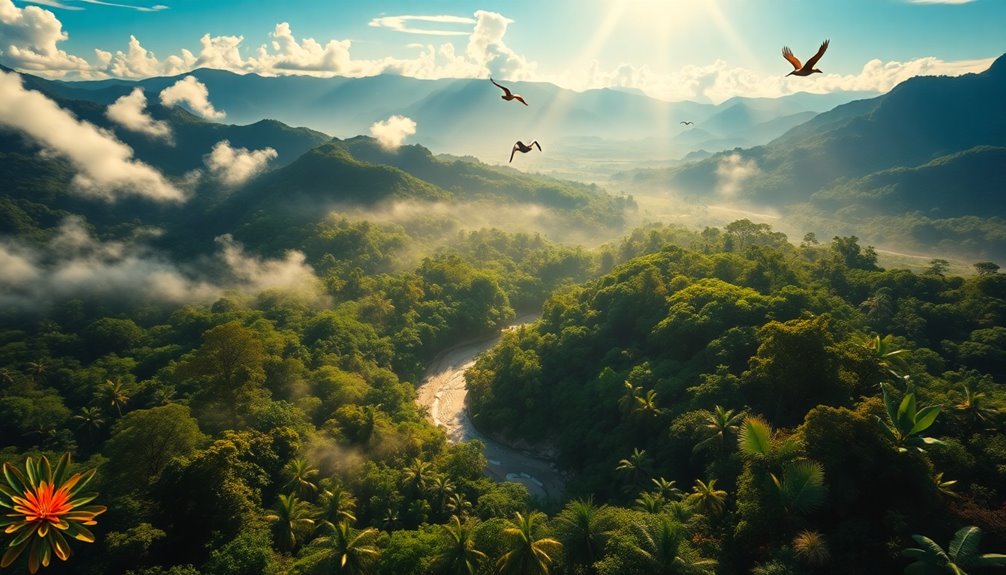
Recognizing the urgent need for action, many organizations are stepping up their efforts to protect biodiversity hotspots around the globe. They combat wildlife crime, rescue animals, and conserve unique ecosystems crucial for preserving regional biodiversity. For instance, initiatives in Southeast Asia disrupt trafficking networks to protect endangered species like orangutans. In the Mediterranean Basin, ongoing efforts rescue native wildlife from natural disasters, while in southern and East Africa, conservation strategies focus on safeguarding elephants, which are essential for maintaining ecosystem balance and supporting human livelihoods.
| Region | Focus Area |
|---|---|
| Caribbean | Wildlife rescue |
| Southeast Asia | Disrupting trafficking networks |
| Mediterranean Basin | Rescue from natural disasters |
| Southern Africa | Protecting elephants |
| East Africa | Coastal ecosystem conservation |
Frequently Asked Questions
What Are the Biodiversity Hotspots in Nature?
Biodiversity hotspots are regions rich in unique plant and animal species, where you'll find a high concentration of endemics.
These areas typically boast at least 1,500 unique vascular plants and have experienced significant habitat loss.
Some notable hotspots include the Amazon rainforest, Madagascar, and the Caribbean.
What Is the Richest Biodiversity Hotspot in the World?
The richest biodiversity hotspot in the world is the Amazon rainforest.
When you explore its vast expanse, you'll find around 40,000 plant species, 2.5 million insect species, and over 2,200 vertebrate species. This incredible area accounts for about 10% of all known species on Earth.
However, it's facing severe threats from habitat loss, with over 20% of its original forest destroyed, making conservation efforts essential for its survival and the wildlife it supports.
What Is a Biodiversity Hotspot and Why Is It Important to Protect Such Areas?
A biodiversity hotspot's a region that supports a high number of unique species but has faced significant habitat loss.
It's essential to protect these areas because they play an important role in maintaining ecological balance and provide fundamental services like clean water and air.
What Is an Area Where Biodiversity Is the Richest at Referred to As?
An area where biodiversity is richest is called a biodiversity hotspot.
These regions are teeming with unique plant and animal species, making them essential for ecological balance.
You'll find that they play an important role in supporting ecosystems that provide essential services like clean air and water.
Protecting these hotspots is critical, as they face significant threats from human activities, and losing them would mean losing a wealth of natural heritage.
Conclusion
In protecting biodiversity hotspots, you're not just preserving unique species; you're safeguarding ecosystems that sustain us all. You're championing conservation efforts that restore balance, advocating for sustainable practices that benefit both nature and humanity, and supporting local communities that rely on these rich environments. By acting now—through awareness, action, and advocacy—you're ensuring a vibrant planet for future generations. Together, let's celebrate, protect, and thrive in the world's most precious natural treasures.
